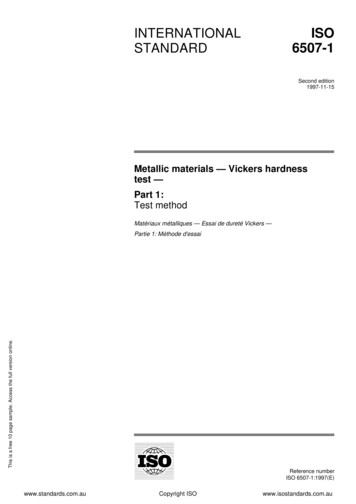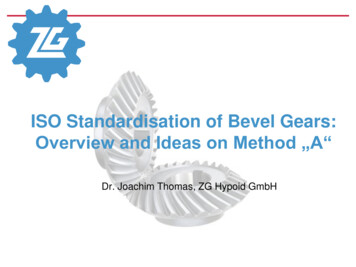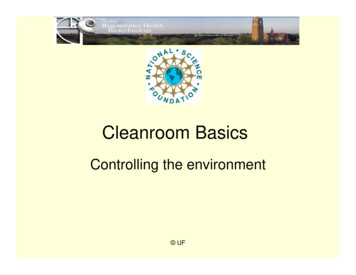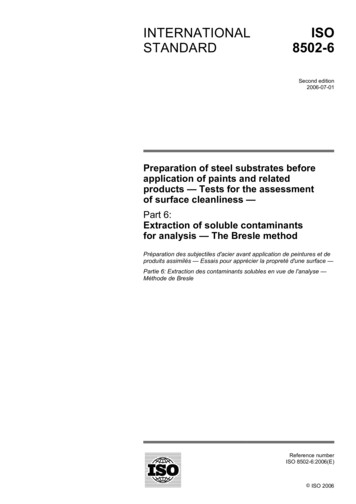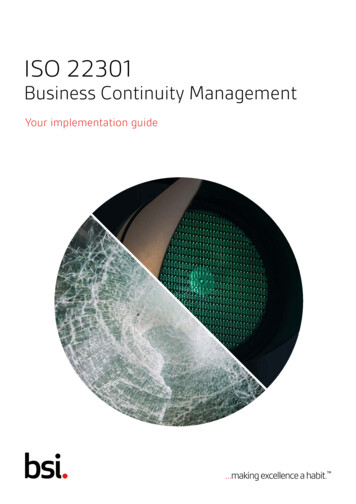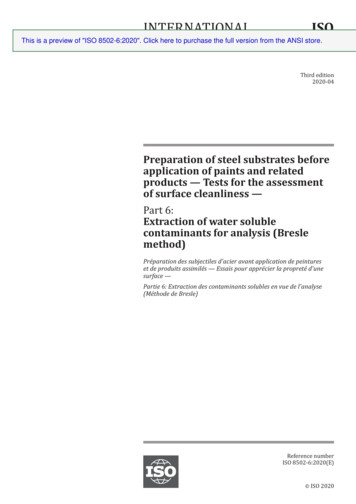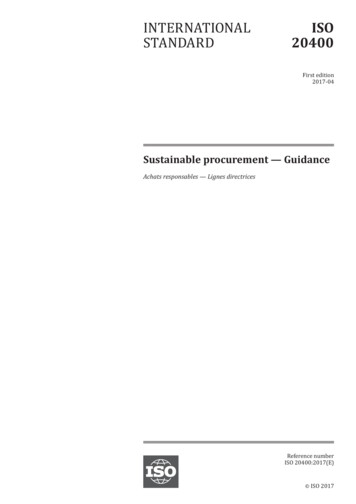
Transcription
INTERNATIONALSTANDARDISO20400First edition2017-04Sustainable procurement — GuidanceAchats responsables — Lignes directricesReference numberISO 20400:2017(E) ISO 2017
ISO 20400:2017(E) COPYRIGHT PROTECTED DOCUMENT ISO 2017, Published in SwitzerlandAll rights reserved. Unless otherwise specified, no part of this publication may be reproduced or utilized otherwise in any formor by any means, electronic or mechanical, including photocopying, or posting on the internet or an intranet, without priorwritten permission. Permission can be requested from either ISO at the address below or ISO’s member body in the country ofthe requester.ISO copyright officeCh. de Blandonnet 8 CP 401CH-1214 Vernier, Geneva, SwitzerlandTel. 41 22 749 01 11Fax 41 22 749 09 47copyright@iso.orgwww.iso.orgii ISO 2017 – All rights reserved
ISO 20400:2017(E) Contents PageForeword.vIntroduction. vi1234567Scope. 1Normative references. 1Terms and definitions. 1Understanding the fundamentals. 74.1Concept of sustainable procurement. 74.2Principles of sustainable procurement. 74.3Core subjects of sustainable procurement. 84.4Drivers for sustainable procurement. 84.5Key considerations for sustainable procurement. 94.5.1Managing risk (including opportunity). 94.5.2Addressing adverse sustainability impacts through due diligence. 104.5.3Setting priorities for sustainability issues. 104.5.4Exercising influence. 114.5.5Avoiding complicity. 11Integrating sustainability into the organization’s procurement policy and strategy.115.1Committing to sustainable procurement. 115.2Clarifying accountability. 125.3Aligning procurement with organizational objectives and goals. 135.4Understanding procurement practices and supply chains. 135.5Managing implementation. 14Organizing the procurement function towards sustainability.146.1Governing procurement. 146.1.1Governance. 146.1.2Procedures and systems. 146.2Enabling people. 156.2.1Organizational culture. 156.2.2Performance management. 156.2.3Learning through collaboration. 156.2.4Guidance. 156.3Identifying and engaging stakeholders. 166.3.1Identifying key stakeholders. 166.3.2Engaging the supply chains. 176.3.3Engaging other stakeholders. 186.4Setting sustainable procurement priorities. 186.4.1Applying risk management. 186.4.2Using different approaches to set priorities. 196.5Measuring and improving performance. 216.5.1Defining metrics and indicators. 216.5.2Reporting. 226.5.3Benchmarking. 236.6Establishing a grievance mechanism. 23Integrating sustainability into the procurement process.247.1Building on the existing process. 247.2Planning. 257.2.1Integrating key elements of sustainable procurement. 257.2.2Assessing sustainability risks (including opportunities). 257.2.3Analysing the costs. 267.2.4Analysing organizational needs. 277.2.5Analysing the market. 277.2.6Completing the sourcing strategy. 28 ISO 2017 – All rights reserved iii
ISO 20400:2017(E) 7.37.47.57.6Integrating sustainability requirements into the specifications. 297.3.1Defining sustainable procurement criteria. 297.3.2Choosing the types of requirements. 307.3.3Applying minimum and optional requirements. 307.3.4Finding information to establish the requirements. 317.3.5Evaluating that sustainability requirements are met. 31Selecting suppliers. 327.4.1Assessing the capacity of suppliers. 327.4.2Prequalifying suppliers. 337.4.3Managing tenders. 347.4.4Awarding the contract. 35Managing the contract. 367.5.1Managing the supplier relationship. 367.5.2Implementing the contract. 377.5.3Using a contract management plan. 377.5.4Managing performance and relationships. 387.5.5Encouraging supplier-customer joint initiatives. 387.5.6Managing supplier failure. 397.5.7Managing disposal and end of life. 39Reviewing and learning from the contract. 39Annex A (informative) Sustainable procurement issues.41Annex B (informative) Overview of ISO 26000.47Annex C (informative) Examples of a sustainability issue approach.49Bibliography. 51iv ISO 2017 – All rights reserved
ISO 20400:2017(E) ForewordISO (the International Organization for Standardization) is a worldwide federation of national standardsbodies (ISO member bodies). The work of preparing International Standards is normally carried outthrough ISO technical committees. Each member body interested in a subject for which a technicalcommittee has been established has the right to be represented on that committee. Internationalorganizations, governmental and non-governmental, in liaison with ISO, also take part in the work.ISO collaborates closely with the International Electrotechnical Commission (IEC) on all matters ofelectrotechnical standardization.The procedures used to develop this document and those intended for its further maintenance aredescribed in the ISO/IEC Directives, Part 1. In particular the different approval criteria needed for thedifferent types of ISO documents should be noted. This document was drafted in accordance with theeditorial rules of the ISO/IEC Directives, Part 2 (see www .iso .org/ directives).Attention is drawn to the possibility that some of the elements of this document may be the subject ofpatent rights. ISO shall not be held responsible for identifying any or all such patent rights. Details ofany patent rights identified during the development of the document will be in the Introduction and/oron the ISO list of patent declarations received (see www .iso .org/ patents).Any trade name used in this document is information given for the convenience of users and does notconstitute an endorsement.For an explanation on the voluntary nature of standards, the meaning of ISO specific terms andexpressions related to conformity assessment, as well as information about ISO’s adherence to theWorld Trade Organization (WTO) principles in the Technical Barriers to Trade (TBT) see the followingURL: www .iso .org/ iso/ foreword .html.This document was prepared by Project Committee ISO/PC 277, Sustainable procurement.In the development of this document, ISO Guide 82 has been taken into account in addressingsustainability issues. ISO 2017 – All rights reserved v
ISO 20400:2017(E) IntroductionEvery organization has environmental, social and economic impacts.Procurement is a powerful instrument for organizations wishing to behave in a responsible way andcontribute to sustainable development and to the achievement of the United Nations SustainableDevelopment Goals. By integrating sustainability in procurement policies and practices, includingsupply chains, organizations can manage risks (including opportunities) for sustainable environmental,social and economic development.Sustainable procurement represents an opportunity to provide more value to the organizationby improving productivity, assessing value and performance, enabling communication betweenpurchasers, suppliers and all stakeholders, and by encouraging innovation.This document assists organizations in meeting their sustainability responsibilities by providing anunderstanding of:— what sustainable procurement is;— what the sustainability impacts and considerations are across the different aspects of procurementactivity:— policy;— strategy;— organization;— process;— how to implement sustainable procurement.Figure 1 presents the structure of this document.This document is applicable to any organization, public or private, regardless of its size and location.It is intended to be understood by any stakeholder involved in, or impacted by, procurement decisionsand processes. The implementation of this document takes into account the particular context andcharacteristics of each organization, scaling the application of the concepts to suit the size of theorganization. The adoption of this document by large organizations promotes opportunities for smalland medium-sized organizations in their supply chains.Clause 4 provides an overview of sustainable procurement. It describes the principles and core subjectsof sustainable procurement and examines why organizations undertake sustainable procurement.Important consideration is given to managing risks (including opportunities), addressing adversesustainability impacts through due diligence, setting priorities, exercising positive influence andavoiding complicity.Clause 5 provides guidance on how sustainability considerations are integrated at a strategic levelwithin the procurement practices of an organization, to ensure that the intention, direction and keysustainability priorities of the organization are achieved. It is intended to assist top management indefining a sustainable procurement policy and strategy.Clause 6 describes the organizational conditions and management techniques needed to successfullyimplement and continually improve sustainable procurement. The organization ensures thatsuch conditions and practices are in place in order to assist individuals with responsibility for theprocurement of goods or services integrate sustainability considerations into the procurement process.Clause 7 addresses the procurement process and is intended for individuals who are responsible for theactual procurement within their organization. It is also of interest to those in associated functions, as itdescribes how sustainability considerations are integrated into existing procurement processes.vi ISO 2017 – All rights reserved
ISO 20400:2017(E) Figure 1 — Schematic view of the content of ISO 20400 ISO 2017 – All rights reserved vii
INTERNATIONAL STANDARD ISO 20400:2017(E)Sustainable procurement — Guidance1 ScopeThis document provides guidance to organizations, independent of their activity or size, on integratingsustainability within procurement, as described in ISO 26000. It is intended for stakeholders involvedin, or impacted by, procurement decisions and processes.2 Normative referencesThere are no normative references in this document.3 Terms and definitionsFor the purposes of this document, the following terms and definitions apply.ISO and IEC maintain terminological databases for use in standardization at the following addresses:— ISO Online browsing platform: available at http:// w ww .iso .org/ obp— IEC Electropedia: available at http:// w ww .electropedia .org/ 3.1circular economyeconomy that is restorative and regenerative by design, and which aims to keep products, componentsand materials at their highest utility and value at all times, distinguishing between technical andbiological cycles[SOURCE: Adapted from Ellen MacArthur Foundation[24]]3.2decent workwork performed in conditions of freedom, equity, security and human dignity[SOURCE: Adapted from ISO 26000:2010, 6.4.1.1, Box 8]3.3due diligenceprocess through which organizations (3.16) proactively identify, assess, prevent, mitigate and accountfor how they address their actual and potential adverse impacts as an integral part of decision-makingand risk management (3.22)3.4environmental labelclaim which indicates the environmental aspects of goods (3.7) or services (3.23)Note 1 to entry: An environmental label or declaration may take the form of a statement, symbol or graphic ona product or package label, in product literature, in technical bulletins, in advertising or in publicity, amongstother things.[SOURCE: ISO 14020:2000, 2.1, modified — The alternative term “environmental declaration” has beendeleted, and the words “product or service” have been replaced by “goods or services” in the definition] ISO 2017 – All rights reserved 1
ISO 20400:2017(E) 3.5ethical behaviourbehaviour that is in accordance with accepted principles of right or good conduct in the context of aparticular situation and is consistent with international norms of behaviour (3.9)[SOURCE: ISO 26000:2010, 2.7]3.6fair operating practicesoperating practices that concern ethical conduct in an organization (3.16) and with other organizations,such as suppliers (3.30), with which it has relationshipsNote 1 to entry: In a sustainable procurement (3.38) context, fair operating practices can potentially extend toinclude the relationships between organizations, their suppliers and organizations and others that interact withthe suppliers. These include interactions with government agencies, partners, suppliers, sub-contractors, andcommunities, with the aim of promoting a healthy relationship between the companies that buy goods (3.7) orservices (3.23) and those providing them.[SOURCE: Adapted from ISO 26000:2010, 6.6]3.7goodsitems or materials that, upon the placement of a purchase order, are being manufactured, processed,handled or transported within the supply chain (3.32) for usage or consumption by the organization (3.16)[SOURCE: ISO 28001:2007, 3.11, modified — The word “purchaser” has been replaced by “organization”]3.8indicatormeasurable representation of the condition or status of operations, management, or conditions[SOURCE: ISO 14031:2013, 3.15]3.9international norms of behaviourexpectations of socially responsible organizational behaviour derived from customary internationallaw, generally accepted principles of international law, or intergovernmental agreements that areuniversally or nearly universally recognizedNote 1 to entry: Intergovernmental agreements include treaties and conventions.Note 2 to entry: Although customary international law, generally accepted principles of international law andintergovernmental agreements are directed primarily at states, they express goals and principles to which allorganizations (3.16) can aspire.Note 3 to entry: International norms of behaviour evolve over time.[SOURCE: ISO 26000:2010, 2.11]3.10key performance indicatorKPIindicator (3.8) of performance deemed by an organization (3.16) to be significant and giving prominenceand attention to certain aspects[SOURCE: ISO 14031:2013, 3.17]3.11labour practicespractices relating to work performed within, by or on behalf of the organization (3.16), includingsubcontracted work[SOURCE: Adapted from ISO 26000:2010, 6.4]2 ISO 2017 – All rights reserved
ISO 20400:2017(E) 3.12life cycleconsecutive and interlinked stages of a goods (3.7) or services (3.23) system, from raw materialacquisition or generation from natural resources to final disposal[SOURCE: ISO 14044:2006, 3.1, modified — The word “product” has been replaced by “goods orservices”]3.13life cycle approachconsideration of life cycle (3.12) in decision-making or development processes3.14life cycle costingLCCmethod for calculating the costs of goods (3.7) or services (3.23) throughout their life cycle (3.12)3.15objectiveresult to be achieved[SOURCE: ISO 9000:2015, 3.7.1, modified — Notes to entry have been deleted]3.16organizationperson or group of people that has its own functions with responsibilities, authorities and relationshipsto achieve its objectives (3.15)Note 1 to entry: The concept of organization includes, but is not limited to, sole-trader, company, corporation,firm, enterprise, authority, partnership, association, charity or institution, or part or combination thereof,whether incorporated or not, public or private.[SOURCE: ISO 9000:2015, 3.2.1, modified — Note 2 to entry has been deleted]3.17policyintentions and direction of an organization (3.16) as formally expressed by its top management[SOURCE: ISO 9000:2015, 3.5.8, modified — Note 1 to entry has been deleted]3.18procurementactivity of acquiring goods (3.7) or services (3.23) from suppliers (3.30)Note 1 to entry: The procurement process considers the whole cycle from identification of needs through to theend of a services contract or the end of the life of goods, including disposal.Note 2 to entry: Sourcing is a part of the procurement process that includes planning, defining specifications(3.26) and selecting suppliers.3.19requirementprovision that conveys criteria to be fulfilled by goods (3.7), processes or services (3.23)[SOURCE: ISO/IEC Guide 2:2004, 7.5, modified — The words “goods, processes or services” have beenadded at the end of the definition]3.20riskeffect of uncertainty on objectives (3.15)Note 1 to entry: An effect is a deviation from the expected — positive and/or negative. ISO 2017 – All rights reserved 3
ISO 20400:2017(E) Note 2 to entry: Objectives include maximizing the contribution to sustainable development (3.37).Note 3 to entry: Risk is often characterized by reference to potential events and consequences, or a combinationof these.Note 4 to entry: Risk is often expressed in terms of a combination of the consequences of an event (includingchanges in circumstances) and the associated likelihood of occurrence.Note 5 to entry: Uncertainty is the state, even partial, of deficiency of information related to, understanding orknowledge of, an event, its consequence, or likelihood.[SOURCE: ISO Guide 73:2009, 1.1, modified — Note 2 to entry has been changed]3.21risk assessmentoverall process of risk (3.20) identification, risk analysis and risk evaluation[SOURCE: ISO Guide 73:2009, 3.4.1]3.22risk managementcoordinated activities to direct and control an organization (3.16) with regard to risk (3.20)[SOURCE: ISO Guide 73:2009, 2.1]3.23serviceresults generated by activities at the interface between a supplier (3.30) and a customer and by supplierinternal activities to meet customer needs[SOURCE: ISO 5127:2001, 5.5.01]3.24small and medium-sized organizationSMOorganization (3.16) defined by a number of employees or size of financial activities that fall undercertain thresholds, which vary from country to country3.25social responsibilityresponsibility of an organization (3.16) for the impacts of its decisions and activities on society and theenvironment, through transparent and ethical behaviour (3.5) that— contributes to sustainable development (3.37), including health and the welfare of society;— takes into account the expectations of stakeholders (3.28);— is in compliance with applicable law and consistent with international norms of behaviour (3.9); and— is integrated throughout the organization and practised in its relationshipsNote 1 to entry: Activities include goods (3.7), services (3.23) and processes.Note 2 to entry: Relationships refer to an organization’s activities within its sphere of influence (3.27).[SOURCE: ISO 26000:2010, 2.18, modified — The word “products” has been replaced by “goods” inNote 1 to entry]3.26specificationdocument stating requirements (3.19)[SOURCE: ISO 9000:2015, 3.8.7, modified — Example and Notes to entry have been deleted]4 ISO 2017 – All rights reserved
ISO 20400:2017(E) 3.27sphere of influencerange/extent of political, contractual, economic or other relationships through which an organization(3.16) has the ability to affect the decisions or activities of individuals or organizationsNote 1 to entry: The ability to influence does not, in itself, imply a responsibility to exercise influence.Note 2 to entry: Leverage in the context of the UN Guiding Principles on Business and Human Rights is a specificform of influence considered to exist where an organization can effect change in the wrongful practices of anentity that causes harm.[SOURCE: ISO 26000:2010, 2.19, modified — Note 2 to entry has been changed]3.28stakeholderindividual or group that has an interest in any decision or activity of an organization (3.16)[SOURCE: ISO 26000:2010, 2.20]3.29subcontractororganization (3.16) or individual contracted by the supplier (3.30) to perform a specific part of a contract3.30supplierorganization (3.16) that provides goods (3.7) or services (3.23)[SOURCE: ISO 9000:2015, 3.2.5, modified — The words “a product or a service” have been replaced by“goods or services”]3.31local suppliersupplier (3.30) to the organization (3.16) that is based in the same geographic marketNote 1 to entry: The term “local” can refer to the surrounding community operations, to a region within acountry, or a country.3.32supply chainsequence of activities or parties that provides goods (3.7) or services (3.23) to the organization (3.16)[SOURCE: ISO 26000:2010, 2.22, modified — The word “products” has been replaced by “goods”]3.33sustainabilitystate of the global system, including environmental, social and economic aspects, in which the needsof the present are met without compromising the ability of future generations to meet their own needsNote 1 to entry: The environmental, social and economic aspects interact, are interdependent and are oftenreferred to as the three dimensions of sustainability.Note 2 to
ISO 20400:2017(E) Foreword ISO (the International Organization for Standardization) is a worldwide federation of national standards bodies (ISO member bodies). The work of preparing International Standards is normally carried out through ISO technical committees. Each



